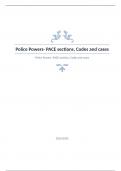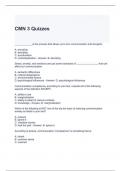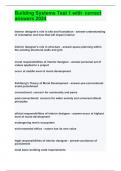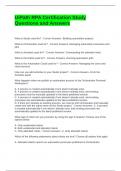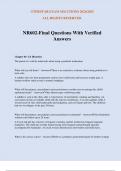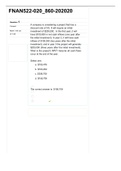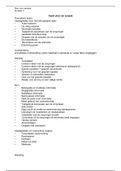SYNERGY
MAIN TAKEAWAYS
- As a selection mechanism corporate strategy mainly shapes boundaries of a firm and the level of diversification
- As a synergy mechanism corporate strategy mainly shapes synergies between businesses and innovation
- Companies need to define internally consistent strategies tailored to a firm’s resources and opportunities to create a meaningful
corporate advantage
- 4 synergy types driven by similarity for resources and need for modification
- Consolidation- similar resources & high modification – one sided synergy – creates value by rationalization across similar
resources by eliminating redundancies
- Combination – similar resources & low modification – two sided synergy- creating value by pooling similar resources
- Customization – dissimilar resources & high modification – one or two sided- Creating value by co-specializing dissimilar
resources in order to create greater joint value
- Connection – dissimilar resources & low modification – two-sided synergy- generates valye by pooling the outputs of dissimilar
value chain actviites with little modification
- Modification increases competitive potential
- According to DCV – four modes of corporate resource creation – reconfiguration processes, leveraging existing resources,
learning, and integration
- Six resource creation configurations = provoked learning configuration, encouraged learning configuration, reconfiguring
support activities, reconfiguring core processes, leveraging configuration, creating integration configuration
- Similarity is not black/white- essentially evert resource is different thus consider the purpose
- Economies of scale indicates that producing more of the same product leads to lower average costs à similar resources
- Economies of scope exists when producing different products together leads to lower average costs than if those products had
been produced separately à dissimilar resources
CORPORATE STRATEGY
C O R P O R A T E S T R A T E G Y D E F IN IT IO N S
- CORPORATE STRATEGY = the way a company creates value through the configuration and coordination of its multi-business
activities
- Corporate strategy is a system of interdependent parts – its success depends on the quality of the individual elements and
how those elements reinforce one another
- Corporate advantage exists when owning a set of businesses leads to more value and higher returns when those businesses
are not owned by one organization
- Companies need to define internally consistent strategies tailored to a firm’s resources and opportunities to create a
meaningful corporate advantage
· Corporate advantage test assesses whether owning the value of business A and B is higher than the standalone value
of the businesses, while the synergy test assesses whether modifying these businesses by integrating their activities
enhances their value
CORPORATE STRATEGY VS BUSINESS STRATEGY
- Business strategy elements
· Decisions about how we compete in a business
· About creating competitive advantage
· Competitors are main rivals in the industry
- Corporate strategy advantages
· Decisions in which businesses we compete
· About creating corporate advantage
· Competitors are those that can assemble same portfolio
T W O M E C H A N IS M S O F C O R P O R A T E S T R A T E G Y
SELECTION MECHANISM
- Portfolio assembly
- Decisions about in which businesses to be active
- Decisions about which businesses to jointly own
SYNERGY MECHANISM
- Business modification
- Decisions about inter-business activities
- Decisions about which businesses to jointly operate
- Corporate strategy is increasingly viewed as a synergy mechanism
C O R P O R A T E S T R A T E G Y F O U R A R E A S O F A T T E N T IO N
AS A SELECTION MECHANISM CORPORATE STRATEGY MAINLY SHAPES:
BOUNDARIES OF A FIRM
- What does a firm own and what not?
- What constitutes the corporate portfolio of businesses?
- Organic vs inorganic + make-or-buy decisions
LEVEL OF DIVERSIFICATION
- Traditionally shaped by product-market-combinations, currently more by business models -what/who/how?-
- Single businesses vs multiple businesses
- Level of relatedness of businesses
Page 1 of 24
, AS A SYNERGY MECHANISM CORPORATE STRATEGY MAINLY SHAPES:
SYNERGIES BETWEEN BUSINESSES
- Level of complementarity of business resources
- Bringing business resources together
- Accessing external resources through acquisitions and alliances – organic vs inorganic growth decisions
INNOVATION
- Integrating corporate wide knowledge resources
- Organizing and coordinating R&D
- Accessing external knowledge resources
SYNERGIES
S Y N E R G Y IN T R O D U C T IO N
- SYNERGY represents ways in which the cash flows and discount rates can be modified through joint operation – collaboration
and joint decision-making- across them
- OPERATIONAL SYNERGY: potentially exists if two business operated jointly are more valuable than the two businesses
operated independently, where ‘operated jointly’ implies that decisions across the two businesses are coordinated with the
aim of enhancing joint value (investors cannot control this)
- Operational synergies between businesses entail coordinated decisions about the operations of each business
- Operational synergies between businesses ultimately must be traceable to links between the value chains of the respective
businesses and the resources underlying them
- SYNERGY TEST à 𝑉(𝐴𝐵) > 𝑉(𝐴) + 𝑉(𝐵), where 𝑉(𝐴) is the NPV of business A when operated independently, 𝑉(𝐵) the NPV of
business B when operated independently, and 𝑉(𝐴𝐵) the NPV of businesses A and B when they operate jointly
- Synergies are two-sides if both businesses benefit, and are one-sided when one businesses gains more than the other
business loses
- NEGATIVE SYNERGIES – when the value is lower than the sum of their values when they operate independently- e.g. brand
dilution and organizational complexity,
MAIN SYNERGY APPROACHES
- Cost reducing synergies
· Economies of scale and sub additive
· Similar resources drive cost reducing synergies
- Revenue enhancing synergies
· Super additive
· Dissimilar resources drive cost reducing synergies
4C SYNERGY OPERATORS
- The four synergy operators are obtained by crossing two dimensions:
the similarity of the resources underlying the value chain of activities
being linked and the extent of modification of the resources
underlying these value chain activities that is necessary for value
creation
SIMILARITY OF RESOURCES
- Economies of scale indicates that producing more of the same
product leads to lower average costs à similar resources
- Economies of scope exists when producing different products together leads to lower average costs than if those products
had been produced separately à dissimilar resources
MODIFICATION OF RESOURCES
- Modification generally enhances the competition potential of a synergy
- However, high modification could lead to frictions that will eat into the value created by synergies
SYNERGY OPERATORS AND THEIR ATTRIBUTES
Consolidation Combination Customization Connection
Involves linking Similar resources Similar resources Dissimilar resources Dissimilar resources
Degree of resource modification High initially Low High Low
Need for active collaboration High initially, low eventually Moderate, constant over Moderate, constant over time Low, constant over time
between personnel from time
different value chains involves
Impact: one sided or two sided One sided Two sided One sided or two sided Two sided
Key value driver Modifying the value chain Increasing bargaining power Modifying the value chain activities Pooling the outputs of
activities by disposal/better by pooling the unmodified through specializing them to each unmodified value chain
utilization of underutilized activities of the value chain other to increase their combined activities to increase their
resources or excess capacity activities value value
Value driver affected Cost/assets Cost/revenues Cost/ revenues/ assets Revenues
Examples Eliminate redundancy Gain bargaining power R&D customized to manu facturing; Cross-selling; product
(or share excess capacity) in relative to suppliers; market software custo mized to hardware; bundling; linking product
functions/ operations/ power; government application of one partner's development of one company
technology development business model/knowledge on to distribution channels of
projects/sales another's assets; "solution" selling; another; sharing brands
forces/plants/equipment (i.e., joint product development
tangible assets)
Extra Creates value by Creating value by pooling Creating value by co-specializing Generates value by pooling the
rationalization across similar similar resources dissimilar resources in order to outputs of dissimilar value
resources by eliminating create greater joint value chain activities with little
redundancies Requires significant levels of modification
ongoing collaboration between
partners
Page 2 of 24
, RESOURCE BASED VIEW AND DYNAMIC CAPABILITY
R E S O U R C E B A S E D V IE W
CORE PRINCIPLES OF RBV
- An organization is a bundle of resources, if those are simultaneously valuable, rare, imperfectly imitable, and non-substitutable,
they are a firm’s main source of sustainable competitive advantage
- Rents accrue to the resources controlled by the firm that meet the VRIN conditions leading to super normal profits when
captured by the firm rather than by resource suppliers
VRIN
- VALUABLE – a resource is valuable to the firm if it generates rents that can be captured by the firm
- RARE – a resource which is not commonly found across other competing firms – enabling superior margins or volume
- INIMITABLE – if the resource is difficult to replicate – causal ambiguity, information asymmetries, social complexity
- NON-SUBSTITUTABLE – if it cannot be easily replaced by another resource that delivers the same effect
- Valuable and rare determine the rent0generating potential at a point in time
- Inimitability and non-substitutability determine rent-generating potential over time
D Y N A M IC C A P A B IL IT Y V IE W
- Dynamic capability approach focuses attention on the firm’s ability to renew its resources in line with changes in its
environment
- Dynamic capabilities refer to the firm’s ability to alter the resource base by creating, integrating, recombining, and releasing
resources – may involve processes of coordination, replication, learning, and reconfiguration
- Dynamic capabilities are built rather than bought, are embedded in the organization, and are likely to be path-dependent
routines
MODES OF CORPORATE RESOURCE CREATION
RECONFIGURATION PROCESS
- Reconfiguration processes transform and recombine assets and resources
- Two forms of reconfiguration
1. Consolidation of support activities
2. Reconfiguration to achieve economies of scale in core processes across BUs
LEVERAGING EXISTING RESOURCES
- Resource leverage is a form of related diversification
- An existing resource can be leveraged in two ways
1. The application or scope of the resource is extended into other domains of the corporation
2. The resource is replicated
LEARNING
- A process by which repetition and experimentation enable tasks to be performed better and quicker
- There are two learning strategies:
1. Operating through a supportive culture – encouraging BUs, encouraging experiments and tolerating failures,
introducing new knowledge, establishing dialogue across BUs
2. Provoke resource creation through tough controls
INTEGRATION
- Concerns the firm’s ability to coordinate and integrate its resources and assets
- It relates to the ways in which the components are integrated and lined together into a coherent whole and by encouraging
BUs to pool their skills and resources with other BUs or encouragement of cross-divisional linkages
D E S IG N P A R A M E T E R S O F D Y N A M IC C A P A B IL IT IE S
- The structures and processes needed to deliver the modes of corporate resource creation
- SU strategic autonomy – scope and discretion of BU managers to make decisions
- SBU similarity – similarity between -relatedness of- Bus, in a broad sense
- Coordination across levels – the degree or extent to which coordination must be effected between the center and Bus
- Coordination between BUs – level of inter-BU coordination
- Performance measures and BU orientation – measured used to judge BU performance and degree of corporate identification
R E S O U R C E C R E A T IO N C O N F IG U R A T IO N S
PROVOKED LEARNING CONFIGURATION
- Rewards based on achievement of tough financial controls
- BUs are provoked into creating resources in order to meet the imposed performance targets
- Relationships between the center and BUs are arm length and based on short term profit performance
ENCOURAGED LEARNING CONFIGURATION
- Rewards based on financial and non-financial measures
- Similar to provoked learning configuration but the center is sensitive to the need for BUs to invest in the creation of future
assets and resources, which is reflected in the performance measures and targets
RECONFIGURING SUPPORT ACTIVITIES
- The center configures loosely coupled support activities, and conducts these activities on behalf of BUs
- BUs need to be similar so that they can use the centralized support functions with a high degree of coordination needed to link
the centralized activities and the BUs
RECONFIGURING CORE PROCESSES
- The center delivers resources by reconfiguring core processes to exploit economies of scale
- The BUs are highly dependent on these centrally controlled resources and thus only partially profit accountable
Page 3 of 24

